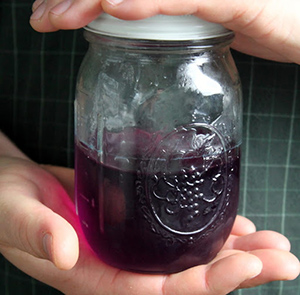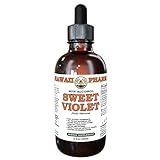Table of Contents
The sweet violet plant belongs to the same family as the pansy. Both flowers are beautiful and delicate. The sweet violet has two petals growing up and three down, while the pansy has four up and one down.
- Sweet Violet NON-Alcohol liquid extract contains ONLY natural ingredients!
- High Quality Sweet Violet Tincture Supplement – we use classic conventional methods of extraction! We meticulously produce our extracts according to precise standards where each herb is extracted according to the distinct characteristic of each plant!
In the 15th century B.C., Hippocrates recommended the sweet violet plant to treat migraines. In the early 20th century, they were supposed to heal cancer, which has yet to be proven. This violet is one of the most appreciated pectoral plants in phytotherapy.

Sweet Violet Plant Scientific Facts
- Other names: Garden violet.
- French: Violette.
- Spanish: Violetta
- Environment: Wet forests and meadows all over Europe. The plant is widespread, though not very common because it was spread and cultivated in America.
- Description: This vibrant plant of the Violaceae family grows from 5 to 15 cm high. It does not have aerial stems; hence, its leaves and flowers grow from a central root in prominent peduncles. The flowers are characteristic violet (more rarely white or pink) with five petals and a strong aroma.
- Parts of the plant used medicinally: Flowers, leaves, and roots.
Healing Properties and Indications

The whole plant contains saponins (especially its root), with expectorant and diuretic properties; mucilage, with emollient, bechic (antitussive) and laxative properties; salicylic acid, with anti-inflammatory and sudorific properties; coloring substances (anthocyanins), and glycosides, to which it owes its mild diuretic properties, as well as essence in the flowers, which gives the plant its pleasant aroma. The flowers have the following applications:

- Respiratory disorders: Due to their content in saponins, the sweet violet plant flowers make the bronchial secretions more liquid, reduce the congestion of the bronchi, and ease coughing. The mucilage exerts a soothing and anti-inflammatory action on all mucous membranes. The mucilage of the sweet violet acts specifically on the respiratory mucous membranes. The violet is, thus, a beneficial plant in treating bronchial catarrh, bronchitis, tracheitis, and bronchial pneumonia. They also have sudorific properties and are especially recommended when respiratory afflictions are accompanied by fever, as in influenza. Their mild diuretic and laxative properties are suitable for people suffering from fever.
- Cystitis: The sweet violet plant is recommended in this case due to the anti-inflammatory action exerted by the mucilage on the urinary system.
- Migraines and headaches: Sweet violet flowers have been successfully used since ancient times, though it is unknown which active principles are responsible for this action. They are traditionally applied orally (infusion) and in compresses or fomentations on the forehead.
- Mouth and throat disorders: Violet infusion is used externally to make rinses or gargles for stomatitis (inflammation of the mucous membrane of the mouth), gingivitis, pharyngitis, tonsilitis, laryngitis, and aphonia.
- It is also applied in eye irrigations for blepharitis (inflammation of the eyelids) and conjunctivitis.
The leaves of the sweet violet plant have similar properties to those of the flowers, though with more substantial sudorific, diuretic, and laxative effects. They are usually employed mixed with flowers.
The roots are rich in saponins, having thus emetic (vomitive) properties. They are administered to induce vomiting for food poisoning or upset stomach.
How to use Sweet Violet

- Infusion with 30-40 g of leaves per liter of water. Drink three to four cups daily. It has a good flavor.
- Violet syrup: The syrup can substitute the infusion, especially for children. It is made with 50 g of flowers in cold extract in half a liter of water for 12 hours. After straining, add 200 g of honey and boil for five minutes. Give from one to three spoonfuls every two hours.
- Vomitive decoction, with 10-20 g of ground root and a quarter-liter of water. Boil until it reduces to half. Take one spoonful every five minutes until vomiting occurs.
- Root powder, 1-4 g dissolved in half a glass of water, has a more intense vomitive effect.
- The same infusion is used internally in mouth rinses, gargles, eyelid cleansing, or compresses and fomentations.
Frequently Asked Questions
How does sweet violet support respiratory health?
Sweet violet contains expectorant properties. Expectorants work by thinning mucus and making it easier to cough up, relieving chest congestion. The saponins in the plant may contribute to its soothing effect on the throat and respiratory passages.
Can sweet violet help manage lymphatic congestion?
Sweet violet is traditionally considered a lymphatic herb, suggesting it may support lymphatic drainage and healthy immune function.
Does sweet violet have anti-inflammatory properties?
It contains salicylic acid, a compound related to aspirin. This indicates potential anti-inflammatory effects. Studies on the anti-inflammatory effects of sweet violet are limited but suggest some possible benefits.
Can sweet violet be used for skin conditions?
The plant has been applied topically for its soothing and cleansing properties.
Is sweet violet beneficial for heart health?
The compound rutin in this plant may support healthy blood circulation and blood vessel health, potentially benefiting cardiovascular function.
Does sweet violet have antioxidant properties?
The plant is a source of antioxidants, such as Vitamin C and flavonoids. Antioxidants help combat oxidative stress, which can damage cells and contribute to disease.
Can sweet violet help with sleep and mood?
Traditionally, the plant has been used to address stress, insomnia, and mild depression.
How do I safely consume sweet violet?
Fresh leaves and flowers can be added to salads or used to make teas. If used in supplement form or for extended periods, consult a healthcare practitioner about appropriate dosages.
Are there any side effects associated with sweet violet?
Sweet violet is generally safe for most people when used appropriately. However, large doses can potentially cause digestive upset.
Where can I find reliable information and resources on sweet violet?
Consult trusted herbal resources like:
Chestnut Herbs https://chestnutherbs.com/violets-edible-and-medicinal-uses/
Review websites like WebMD https://www.webmd.com/vitamins/ai/ingredientmono-212/sweet-violet
Always talk to your doctor about using sweet violet, especially if you have medical conditions or take medications.
DISCLAIMER: All content on this website is presented solely for educational and informational objectives. Do not rely on the information provided as a replacement for advice, diagnosis, or treatment from a qualified medical expert. If you are pregnant, nursing, or have any preexisting medical concerns, talk to your doctor before using any herbal or natural medicines.
REFERENCES
- George D. Pamplona-Roger, M.D. “Encyclopedia of Medicinal Plants.” George D. Pamplona-Roger, M.D. Encyclopedia of Medicinal Plants. Ed. Francesc X. Gelabert. Vols. 1 San Fernando de Henares: Editorial Safeliz, 2000. 344, 345. Print.
- WebMD: https://www.webmd.com/vitamins/ai/ingredientmono-212/sweet-violet
- Indigo Herbs: https://www.indigo-herbs.co.uk/natural-health-guide/sweet-violet/benefits
- Chestnut Herbs: https://chestnutherbs.com/violets-edible-and-medicinal-uses/
- RxList https://www.rxlist.com/supplements/sweet_violet.htm
- Netmeds: https://www.netmeds.com/health-library/post/sweet-violet-health-benefits-uses-of-this-bountiful-herb-recipe-for-banaksha-chai-or-tea
Last update on 2024-07-22 / Affiliate links / Images from Amazon Product Advertising API




